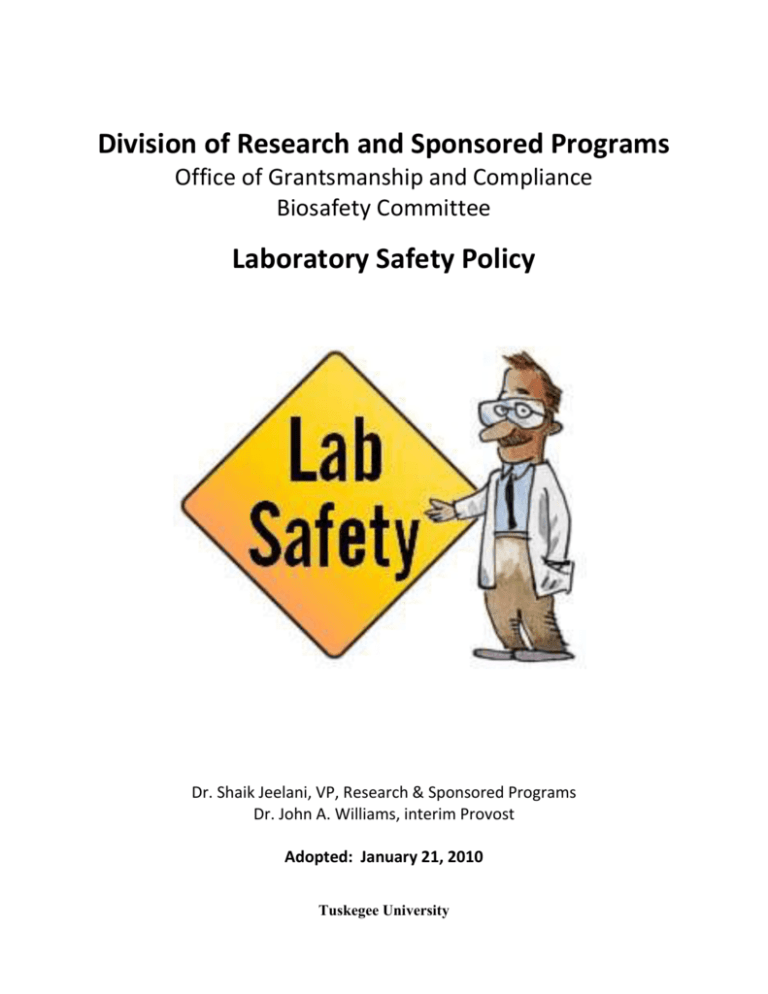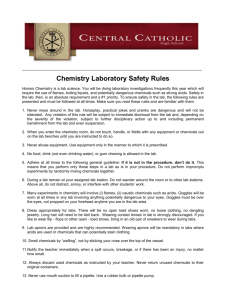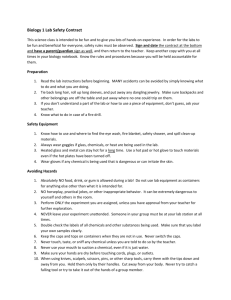Laboratory Safety Policy
advertisement

Division of Research and Sponsored Programs Office of Grantsmanship and Compliance Biosafety Committee Laboratory Safety Policy Dr. Shaik Jeelani, VP, Research & Sponsored Programs Dr. John A. Williams, interim Provost Adopted: January 21, 2010 Tuskegee University Division of Research and Sponsored Programs Biosafety Committee Laboratory Safety Policy Code of Federal Regulations Title 29: Labor Part 1910-Occupational Safety and Health Standards Subpart Z – Toxic and Hazardous Substances 1910.1450 Occupational exposure to hazardous chemicals in laboratories. Scope and application: This section shall apply to all employees engaged in the laboratory use of hazardous chemicals and biological agents. Tuskegee University’s Biosafety Committee (TUBC) develops and implements policies relative to research laboratories. TUBC has the authority to inspect research laboratory for compliance and recommend sanctions for violations to the Vice President for Research and Sponsored Programs for enforcement. The Environmental Safety Officer has the responsibility to inspect research facilities on campus for safety and make recommendations to the provost for corrective actions. It is the policy of the Biosafety Committee that all employees engaged in laboratory work strictly adheres to the following practices as outlined in the aforementioned regulation. All employees working in a laboratory must develop, encourage, and adhere to safe habits and avoid unnecessary exposure to chemicals and biological agents by any route. Research faculty and technologists are fully responsible for the implementation of and adherence to this and other policies governing laboratory practice. Hence, research faculty and technologists must understand established policies/guidelines and ensure that personnel in laboratories assigned to them both understand and observe such policies/ guidelines. Specifically, laboratory personnel will: observe standard precautions outlined in the Laboratory Health and Safety Plan; follow established protocol for each laboratory procedure; allow only authorized trained adult personnel to enter the laboratory, no children; wear closed liquid resistant shoes at all times in the laboratory but do not wear sandals, open toe shoes, perforated shoes, or sneakers; not smell or taste chemicals or any other laboratory substance; use volatile, toxic chemicals only inside an approved fume hood; store chemicals according to the segregation scheme (i.e., state and hazard classes) that keep incompatible chemicals apart, not alphabetically; store volatile and toxic chemicals inside an approved cabinet; date chemicals as to received, placed in use, and expiration date; wear appropriate gloves when the potential for contact exists. Inspect gloves and test glove boxes before use; use only those chemicals or biological agents for which the quality of the available ventilation system is appropriate, i.e., chemical fume or biological safety hood; not eat, drink, chew gum, or apply cosmetics in the laboratory; wash hands before conducting these activities; avoid storage, handling or consumption of food or beverages in storage areas, refrigerators, glassware or utensils which are also used for laboratory operations; handle and store laboratory glassware with care to avoid damage, do not use damaged glassware; dispose sharp and puncturing objects, including broken glass in an approved sharps or broken glass container, not in a regular waste receptacle; dispose biohazard waste in appropriately labeled containers; store biohazard waste in the laboratory until disposed of, not outside the laboratory in the corridors or any area with public access; label waste (chemical or biological) as to its actual content (picric acid), not as the “name of the experiment” waste; dispose of chemicals (especially corrosives and volatiles) according MSDS, not into the drains; wash hands before leaving the laboratory; avoid practical jokes or other behavior which might confuse, startle or distract another worker; not use mouth suction for pipeting or starting a siphon; confine long hair and loose clothing; keep the work area clean and uncluttered, with chemicals and equipment being properly labeled and stored, clean up the work area on completion of an operation or at the end of each day; assure that appropriate eye protection is worn by all person, when appropriate; use appropriate respiratory equipment when air containment concentrations are not sufficiently restricted by engineering controls, inspecting he respirator before use; use any other protective and emergency apparel and equipment as appropriate; avoid use of contact lenses in the laboratory unless necessary, if they are used, inform supervisor so special precautions can be taken; remove laboratory coats immediately upon significant containment; not wear Personal Protective Equipment (PPE) outside of the laboratory. PENALTY: VIOLATION OF ANY OF THE ABOVE ITEMS WILL BE SUBJECT TO THE FOLLOWING: First Violation: Second Violation: Third Violation: Oral warning, immediate correction of the violation, and documentation of the violation and corrective action. Written reprimand and immediate correction of the violation. Suspension of laboratory research activities for 30 days and report submitted to Tuskegee University’s Misconduct Committee. Adopted: January 21, 2010







